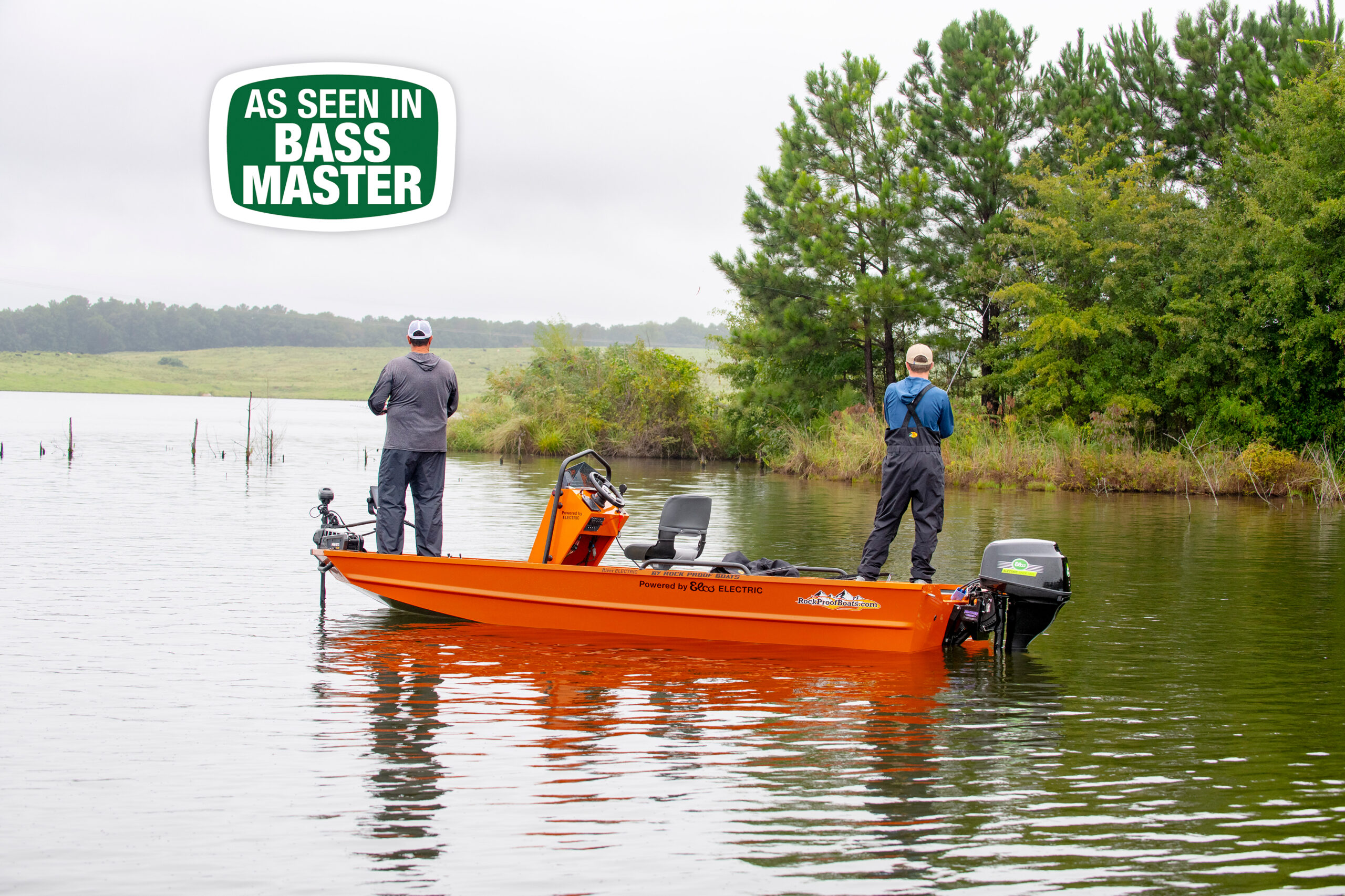
By Doug Olander
In some ways, I considered myself an awful candidate to write an article that would express my reaction to an electric-boat bass-fishing experience. At the same time, I could be an ideal candidate.
That is, on the minus side, I knew nothing about bass fishing from boats powered by electric outboard motors. But on the plus side, I knew nothing about bass fishing from boats powered by electric outboard motors.
That means that I came to this topic without preconceived notions. Indeed, I really didn’t know what to expect when I drove east from Atlanta to a lovely 1,370-acre lake with the unlikely name of Hard Labor Creek Reservoir in Georgia, curious to see what the fuss was about. At the floating dock, I stepped onto a 17 ½-foot Rock Proof Boats aluminum River Electric model designed with electric power in mind by Brent Kauffman. I noticed a “50” on the cowling of the Elco outboard engine, though nowhere did it say “50 horsepower.”
I came to understand that while it looked and performed more or less like a 50-hp gas outboard, Elco and other electric propulsion companies utilize a “comparable” horsepower rating. Why is a bit complicated, but some dumbing-down research helped me understand some of the nuances of electric-outboard power ratings.
To be technically correct, these outboards should be rated in kilowatts, a standard measure of electrical output. One kW equals 1.34 horsepower. Elco specifies that its 50 puts out 26,400 watts or 26.4 kW. Multiplying that output (26.4 kW) times 1.34 hp (per kW) yields 35 hp.
Elco’s engineers point out that the inherent inefficiency of gasoline power and the differences in torque between gas and electric outboards mean the horsepower rated gasoline outboard powerhead ends up somewhat less actual horses — propulsive power —at the prop.. What that boils down to is that Elco’s 50 is more or less comparable to a conventional 50-hp outboard in power.
First Impressions
I joined Brent and his son Josh, and headed to the other side of Hard Labor Creek Reservoir to cast for largemouth. The boat planed out quickly, as I expected. I had driven my daughter’s Tesla and was familiar with its essentially instant torque curve, resulting in scarcely any delay in overcoming inertia. While I had no experience with electric outboards, my gut feeling was that a gas-powered 50 would have given us a bit more top end than we realized, but still, we were zooming across this this fairly large lake where no gas-powered engines are allowed in a loaded boat at about 25 mph.
In fact, my biggest revelation was: no revelations, at least in terms of performance. While running across the lake, we could have had a regular gas outboard on the back. I had rather expected the Elco to be whisper-quiet. It wasn’t, but I realized the noise wasn’t quite as loud as an internal combustion engine, but was also an entirely different sound. Much of that sound, I deduced, came from the water flowing past the lower unit and the hull. I guess when a boat is moving at 25 mph, no matter what sort of power is pushing it, stealth will be hard to come by.
But as we idled to our first fishing spot to start casting, a nice advantage of the electric outboard presented itself. Where a gas outboard would be entirely audible at any speed, the Elco at that low speed was indeed silent. Also, I found that its simple design should allow essentially unlimited trolling at minimal speed, which could supplement or even at times take the place of a bow-mounted trolling motor. The absence of noise and vibration gave little indication that we were under power.
We didn’t do enough running that day to determine how long we could operate on the lithium batteries. But Vincent Daniello’s excellent comparative electric-vs.-gas test for Boating Magazine determined that the same boat went roughly the same speed and roughly as far with both types of power.
Daniello also acknowledges that electric power has issues, some of which are already being addressed by the rapidly developing technology. For one, batteries are heavy. Lithium batteries are far lighter than lead-acid, but either way, an electric outboard has to push a lot of weight. The Rock Proof boat I fished from used four lithium batteries weighing 84.5 pounds each, stowed under the rear deck. (By comparison, 12 gallons of gas weighs 72 pounds.)
Even so, batteries are lighter and more powerful than just a few years ago, and that trend is likely to continue with an exponential curve. Charge time does take longer than filling a gas tank, though that time, too, is expected to decrease. Electric-outboard fans appreciate the cost savings over gasoline (though electricity isn’t free), and also cite their engines’ reliability since they have so few moving parts.
Urban Electric-Only Bass-Fishing Oases
What really took me by surprise that day, from talking to Heinemann and Scott Edwards, a local electric-fishing enthusiasts and member of the High Voltage Bass Anglers club, and subsequent research was the widespread and increasing interest in fishing electric-only waters among a growing segment of bass anglers. I mean, I had no idea, first of all, that so many “electric-only” lakes exist from coast to coast in the U.S. I discovered later any effort to pinpoint these on a statewide basis is a dog that won’t hunt. Few states offer list of lakes and reservoirs where fishing is allowed but the use of gas-powered engines is not. But they’re there, in some states by the dozens.
But the fact remains that many of these waters — which are typically modest in size but can be quite large — are no more than an hour or two from large urban areas. In many cases, these are reservoirs designated for drinking water or as an auxiliary water supply (storage) for said urban populations. Gasoline and drinking water don’t really mix; though modern gas outboards pollute at a rate far lower than older engines, they’re still not completely clean. Some reservoirs allow no recreational use of any kind for any reason, but many more are stocked and managed for sport fishing, with restrictions.
So, let’s see: We have hundreds of lakes in the nation that offer good bass fishing, many fairly or very close to large urban population centers, where anglers can fish for bass without being buzzed by personal watercraft, water skiers or, for that matter, high-speed bass boats. Canoes and kayaks can and do fish here. But for a lot of anglers, paddle craft aren’t a good option, either from physical limitations, comfort or fishing style. The solution? A small boat with an electric outboard such as Elco offers.
In fact, it turns out that a considerable source of the demand for Elco outboards is from bass enthusiasts who live in urban areas and want to really take advantage of the good fishing all around them in lakes that most of their bass-boat buddies can’t fish. Beyond lakes and reservoirs, you’ll find some “no-motor zones” in various coastal areas as well. For example, the Florida Keys National Marine Sanctuary no-motor zone prohibits “internal combustion motors” and limits anglers to “the use of push pole, paddle, sail, electric motor or similar means of propulsion.” In such cases, the regs seem to allow all electrics, making, say, a 50-hp-comparable engine allowed. Some coastal no-motor zones, as with some lakes, specify electric trolling motors only or even prohibit all motors of any type.
Bottom line: Read the fine print before you launch an electric-power boat if uncertain what is allowed, since it can vary from water to water. That’s also a good idea because it can change. To wit: The Pennsylvania Fish and Boat Commission announced in the summer of 2022 its intention to consider updating its regulations governing waters where only electric power is allowed, citing technological advancements. An official from that agency explained on goerie.com that this new electric-propulsion technology “can do things that are above and beyond what that regulation intended” while still meeting “the letter of the law.”
It is likely that officials in many states will take note of this new generation of power, where electric trolling motors previously pushed small craft along at a gentle two or three mph, but where larger boats now zoom around the lake at 25 to 30 mph or more. Since for most electric-only lakes, the original, primary intent was to avoid polluting drinking water, all electric outboards do meet the letter of that law. But that “letter” may be changing, as officials in some cases might place new limits on how much electric power is allowed, or on speeds in general. While no doubt many of the waters across the country that forbid gas engines will continue to allow electric power without regard to size, that may change in some, so, again, simply be aware.
Interest and Technology On the Rise
Meanwhile, just how serious these electric bass fishermen are hit home for me when I talked to Walt Marchant. He’s the EBANC tournament director. That would be the Electric Bass Angling National Championship. Yep: there’s an Electric Fishing Network (sponsored, not surprisingly, by Elco, recognizing the economic importance of this segment of recreational fishing) with a tournament series in which dozens of electric-bass-fishing clubs can compete. Most of those clubs at present are in Georgia, Virginia and Maryland, as well as Pennsylvania and Ohio.
Marchant, who lives in Maryland, says that with the growing popularity of the electric series, he could see it becoming a national program at some point. That growing interest translates into more incentive to expand the limits of what electric outboards can do, by manufacturers such as Elco, as well as a greater interest among anglers in the technology, hungry for more speed and longer battery life. “It’s not uncommon now for anglers to put $40,000 or $50,000 into their electric-powered fishing boat,” Marchand says. At the same time, many electric angling enthusiasts fish these tournaments with relatively inexpensive rigs (and do very well), so while some electric fishermen like to trick out their boats elaborately, others spend far less to fish electrically while spending but a small fraction of what gas-powered bass tourney rigs are worth.
“Electric bass” tournament boats (so far) lack the speed or range that participants rely on in high-speed high-powered bass-boat events. But electric lakes don’t require that speed or distance since few require (or even facilitate) long runs. And of course at the end of the day, their “gas bills” are quite reasonable.
But Marchand points out that all the interest in fishing electric-only tournaments is indicative of the much wider market for electric outboards, since “We have lots of boats fishing these [electric] reservoirs that never do tournaments. Most, in fact.”
These boaters are out there to enjoy a day in the water and catch a few fish. Better still if they can do it without having to drive far, fight crowds on the water or worry about getting run over by other vessels shooting past them. Thanks to the technology of electric outboard motors, this is a great option for bass anglers who are aware of the extensive network of lakes in the U.S. where gas outboards are verboten.


